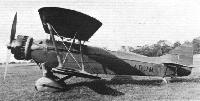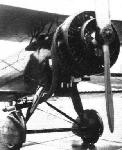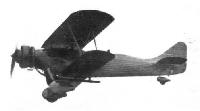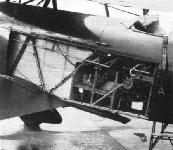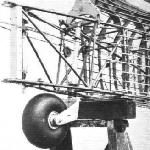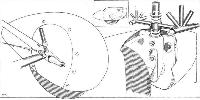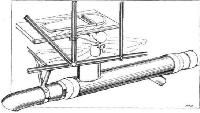
Описание
Страна : Великобритания
Год : 1931
Единственный экземпляр
1-местный почтовый самолет
Avro 627 Mailplane
В 1930 году авиакомпания "Canadian Airways" сформулировала требования к почтовому самолету для использования новой службой "Prairie Air Mail". Согласно данной спецификации фирма "Avro" решила адаптировать готовый самолет - недостроенный второй экземпляр Avro 604 Antelope. Машину предполагалось использовать как основу для истребителя Avro 608 Hawk, однако данный проект до логического завершения доведен не был. Модернизированному самолету присвоили обозначение Avro 622.
По мнению конструкторов фирмы "Avro", в конструкцию самолета Avro 622 не требовалось вносить много изменений. Использовали клееное крыло, хвостовое оперение и шасси самолета Avro 604 в комбинации с фюзеляжем, доработанным за счет использования полотняной обшивки вместо обшивки из легкого сплава. Колеса основных опор шасси получили аэродинамические обтекатели, была предусмотрена возможность замены колес лыжами для взлета со снега или поплавками для взлета с воды. Кабину пилота сместили назад, чтобы освободить место в передней части фюзеляжа для герметичного огненепроницаемого отсека для почты. Были смонтированы система обогрева кабины и оборудование для полетов ночью.
Самолет Avro 627 Mailplane доставили в Канаду для выполнения демонстрационных полетов, но к этому времени заказчик уже не имел финансовых средств для покупки самолета, поэтому Avro 627 вернули в Британию. В 1932 году машина принимала участие в гонках на Королевский кубок, в 1933 году проходила испытания с двигателем Armstrong Siddeley Tiger IV под новым обозначением Avro 654. В 1934 году самолет разобрали.
ТАКТИКО-ТЕХНИЧЕСКИЕ ХАРАКТЕРИСТИКИ
Avro 627 Mailplane
Тип: 1-местный почтовый самолет
Силовая установка: один звездообразный двигатель Armstrong Siddeley Panther IIА, 525 л. с.
Характеристики: макс, скорость на оптимальной высоте 274 км/ч; крейсерская скорость 237 км/ч; скороподъемность 366 м/мин; практич. потолок 5790 м; дальность 900 км
Масса: пустого 1400 кг; максимальная взлетная 2336 кг
Размеры: размах крыла 10,97 м; длина 9,40 м; высота 3,30 м; площадь крыла 35,39 м2
Описание:
- Avro 627 Mailplane
- Flight, August 1931
AN AVRO MAIL PLANE
Фотографии
-
Flight 1931-08 / Flight
Регистрационный номер: G-ABJM [13] This side view shows that the robustness common to all Avro aircraft has not been sacrificed although exceptionally clean lines have been obtained.
-
Мировая Авиация 40
Регистрационный номер: G-ABJM [13] На гонках 1932 года на Королевский кубок самолет Mailplane развил скорость 283 км/ч - это был наилучший показатель в гонках.
-
Flight 1931-08 / Flight
Регистрационный номер: G-ABJM [13] The clean lines and low head resistance, in spite of the large radial engine fitted to the Avro "627" are well depicted in the photographs.
-
Aeroplane Monthly 1982-07 / R.Riding - The 1932 King's Cup air race
Регистрационный номер: G-ABJM [13] The bright yellow Avro Mailplane G-ABJM flown by H. A. Brown, who later became an Avro test pilot. This aircraft recorded the fastest speed for the race, or any previous King's Cup, of 176 m.p.h.
-
Flight 1932-07 / Flight
Регистрационный номер: G-ABJM [13] THIRSTY HORSES: Fuelling the "Panther" engine of the Avro "Mailplane" which scored the fastest time over the course with 176 m.p.h.
-
Flight 1931-08 / Flight
Регистрационный номер: G-ABJM [13] The attention which has been paid to the reduction of drag can be seen by the double form of Townend Ring and the "spats" over the wheels.
-
Flight 1931-08 / Flight
Регистрационный номер: G-ABJM [13] -
Flight 1931-08 / Flight
Регистрационный номер: G-ABJM [13] The side panels of the fuselage may be quickly and easily detached to expose all pipes and control rods for adjustment and maintenance.
-
Flight 1931-08 / Flight
Регистрационный номер: G-ABJM [13] THE ENGINE MOUNTING: Simplicity with efficiency has obviously been maintained throughout in constructing the Avro 627, as the details of the engine mounting will show.
-
Flight 1931-08 / Flight
Регистрационный номер: G-ABJM [13] THE UNDERCARRIAGE: Simplicity with efficiency has obviously been maintained throughout in constructing the Avro 627, as the details of the undercarriage will show.
-
Flight 1931-08 / Flight
Регистрационный номер: G-ABJM [13] THE TAIL WHEEL: The construction of the tail wheel springing can be seen here as well as the tail-plane incidence gear.
-
Flight 1931-08 / Flight
Регистрационный номер: G-ABJM [13] WING DETAILS: The strip steel spars and duralumin ribs exemplify Avro workmanship.
-
Flight 1931-08 / Flight
Регистрационный номер: G-ABJM [13] Our photograph shows the mail compartment with the lid open. This lid folds again twice and so does not impede loading up of the compartment.
-
Flight 1931-08 / Flight
WHEEL DETAILS: On the left the sketch shows the method of attaching the streamline fairing over the landing wheels, while on the right the tail wheel and its springing is shown. The hollow steel fork carrying the wheel (see small sketch) is shown cut through in order that the method of attaching the fairing to a transverse plate may be understood.
-
Flight 1931-08 / Flight
ON BALL BEARINGS: The aileron and elevator hinges are of the ball bearing type, and are not divided, the balls being put into the bearing at the coincidence of a groove in the centre sleeve and a notch in the outer race.
-
Flight 1931-08 / Flight
TWO IMPORTANT JOINTS: That on the left takes the front pair of flying wires and that on the right the front spar of the bottom plane on the Avro "627."
-
Flight 1931-08 / Flight
THE HEATING SYSTEM: The hot air is brought in under the foot boards from a muff round the exhaust pipe, and the supply is controlled by a butterfly valve.
-
Flight 1931-08 / Flight
Avro "Mail Plane" Armstrong Siddeley 525 hp "Jaguar Major" Engine
- Фотографии
